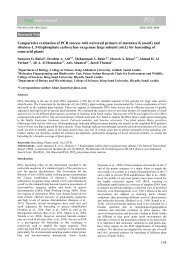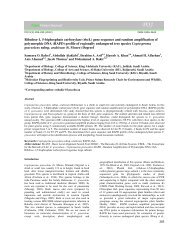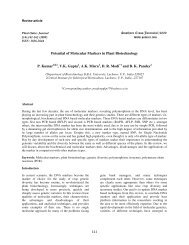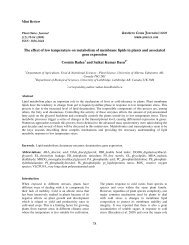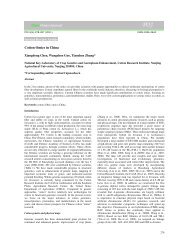Yield and quality management of rose (Rosa hybrida ... - Plant Omics
Yield and quality management of rose (Rosa hybrida ... - Plant Omics
Yield and quality management of rose (Rosa hybrida ... - Plant Omics
Create successful ePaper yourself
Turn your PDF publications into a flip-book with our unique Google optimized e-Paper software.
POJ 3(6):167-171 (2010) ISSN:1836-3644<br />
<strong>Yield</strong> <strong>and</strong> <strong>quality</strong> <strong>management</strong> <strong>of</strong> <strong>rose</strong> (<strong>Rosa</strong> <strong>hybrida</strong> cv. Poison) with plant growth regulators<br />
Hashemabadi D* 1 <strong>and</strong> Mohammad Zarchini 2<br />
1 Department <strong>of</strong> Horticultural Science, Faculty <strong>of</strong> Agriculture, Islamic Azad University, Rasht Branch, Iran<br />
2 Member <strong>of</strong> Young Researchers Club, Islamic Azad University, Rasht Branch, Rasht, Iran<br />
*Corresponding author: davoodhashemabadi@yahoo.com<br />
Abstract<br />
This study was done to evaluate effects <strong>of</strong> different levels <strong>of</strong> salicylic acid (SA) (50, 100, 150 <strong>and</strong> 200 mg l -1 ), gibberellic acid (GA3)<br />
(150, 200, 250 <strong>and</strong> 300 mg l -1 ), <strong>and</strong> cycocel (CCC) (500, 1000, 1500 <strong>and</strong> 2000 mg l -1 ) at pre-harvest stage on the <strong>quality</strong>, yield <strong>and</strong><br />
vase life <strong>of</strong> cut <strong>rose</strong> (<strong>Rosa</strong> <strong>hybrida</strong> ‘Poison’). Results showed that the effects <strong>of</strong> plant growth regulators on bud length, vase life <strong>and</strong><br />
yield were significant (P≤ 0.05). The effect <strong>of</strong> regulators has also been significant at P≤ 0.01 level on fresh weight <strong>and</strong> flower height.<br />
The highest record <strong>of</strong> flower yield was obtained by application <strong>of</strong> 200 mg l -1 GA3 with 192 cut flowers per year per m -2 . The highest<br />
vase life (12.67 days) was obtained when 150 mg l -1 SA applied to cut flowers. The best treatment to increase the stem flower length<br />
was application <strong>of</strong> 300 mg l -1 GA 3 which produced longest cm stems (49.33).<br />
Keywords: Gibberellin, Salisylic acid, Cycocel, <strong>Rosa</strong> <strong>hybrida</strong>, Quality, <strong>Yield</strong><br />
Abbreviations: PGRs; <strong>Plant</strong> growth regulators, GA; Gibberellic acid, SA; Salicylic acid, CCC; Cycocel<br />
Introduction<br />
Rose is one <strong>of</strong> the most popular flowers that used in pot <strong>and</strong> as<br />
cut flower. <strong>Yield</strong> <strong>and</strong> <strong>quality</strong> improvement are important aims<br />
<strong>of</strong> florists. Low yield <strong>and</strong> low <strong>quality</strong> are two problems in Iran<br />
compared to other countries such as the Netherl<strong>and</strong>s, Colombia,<br />
Kenya <strong>and</strong> USA. These problems can be rectified by optimizing<br />
the production conditions <strong>and</strong> utilization <strong>of</strong> plant growth<br />
regulators (PGRs). Good <strong>quality</strong> production is usually achieved<br />
by manipulating growth factors such as light <strong>and</strong> temperature.<br />
These physical factors are very difficult to control <strong>and</strong> perhaps<br />
expensive. <strong>Plant</strong> flowering <strong>and</strong> growth very depended on PGRs<br />
equilibrium <strong>and</strong> plants quickly respond to change <strong>of</strong> hormonal<br />
balance (Khangoli, 2001). <strong>Plant</strong> growth retardants are the most<br />
effective PGRs which exceedingly applied in ornamental plants.<br />
These compounds delay cell division <strong>and</strong> growth in the beneath<br />
apex, but they do not have any effect on meristem (Hedayat,<br />
2001). They supposedly reduce plant growth without affecting<br />
morphological change on leaves <strong>and</strong> shoot numbers. These<br />
compounds may increase yield <strong>and</strong> <strong>quality</strong> <strong>of</strong> cut flower via<br />
controlling plant height, acceleration <strong>of</strong> flowering <strong>and</strong><br />
increasing <strong>of</strong> flower primordia (Khangoli, 2001; Hedayat,<br />
2001). Gibberellins, especially gibberellic acid (GA3) plays an<br />
important role in the growth <strong>and</strong> development <strong>of</strong> plants.<br />
Gibberellins are classified as diverse group <strong>of</strong> plant hormones<br />
that enhance some physiological or biochemical pathways in<br />
plants. The use <strong>of</strong> GA3 for boosting the growth <strong>and</strong> vigor <strong>of</strong><br />
various horticultural plants is very old known <strong>and</strong> well<br />
documented (Gul et al., 2006). GA3 improves yield <strong>and</strong> <strong>quality</strong><br />
<strong>of</strong> ornamental plants via plant growth incitation <strong>and</strong> stem<br />
elongation (Fathipour <strong>and</strong> Esmaellpour, 2000). Arun et al.<br />
(2000) studied the effects <strong>of</strong> different levels <strong>of</strong> GA3 on growth<br />
<strong>and</strong> flowering <strong>of</strong> <strong>rose</strong> “First red” <strong>and</strong> found that GA3 could<br />
improves plant <strong>and</strong> flower neck height, as well flowering stalk.<br />
They observed that all treatments increased bud length, flower<br />
diameter <strong>and</strong> produced the most cut flowers in unit area. GA3<br />
enhances plant growth <strong>and</strong> internode length by increasing the<br />
cell division <strong>and</strong> enlargement. It also increases cell size, stem<br />
height, stem thickness <strong>and</strong> number <strong>of</strong> leaves. Other studies on<br />
the effect <strong>of</strong> GA3 on ornamental plants showed that, GA3<br />
accelerated flowering <strong>and</strong> enhanced plant height (Gul et al.,<br />
2006).<br />
Abdi et al. (2009) showed that the salicylic acid causes a<br />
significant increase on the plant density <strong>and</strong> dry weight <strong>of</strong> root<br />
<strong>and</strong> shoot. Spraying maize plants ‘Single hybrid 10’ with SA<br />
increased dry weight <strong>of</strong> stem, leaves <strong>and</strong> whole plant (Abdi et<br />
al., 2009). Application <strong>of</strong> SA has increased the quantity <strong>of</strong> most<br />
amino acids, except methionine, in plants (Latimer <strong>and</strong> Beden,<br />
1994). SA plays an important role in resistance <strong>of</strong> old leaves<br />
against pathogens, <strong>and</strong> acts as an induction signal for specific<br />
defense responses <strong>of</strong> plants. SA normally operates by producing<br />
low weight proteins with some interesting role in the resistance<br />
(Fathipour <strong>and</strong> Esmaellpour, 2000; Simons, 1991).<br />
<strong>Plant</strong> growth retardants are the biggest group <strong>of</strong> PGRs in<br />
floriculture industry. Bhattacharjee <strong>and</strong> Singh (1995) evaluated<br />
the effect <strong>of</strong> daminozide <strong>and</strong> CCC on <strong>rose</strong> ‘Raktag<strong>and</strong>ha var.’<br />
<strong>and</strong> observed that these compounds had significant effect on<br />
vegetative growth <strong>and</strong> flowering caused to hasten first bud<br />
manifestation, increasing bud length, flower diameter <strong>and</strong> yield<br />
<strong>of</strong> cut flowers up to 9%. Hisamatsu et al. (1998) controlled the<br />
height <strong>of</strong> Pyracantha coccinea ‘Kasan’ <strong>and</strong> ‘Lal<strong>and</strong>e’ by CCC.<br />
On other h<strong>and</strong>, paclobotrazol <strong>and</strong> CCC, two plant growth<br />
retardants, caused less carbohydrate consumption for shoot<br />
167
Table 1. Mean comparison <strong>of</strong> bud lenght, fresh weight <strong>of</strong> flower <strong>and</strong> vase life<br />
Traits Bud length Fresh weight <strong>of</strong> Vase life<br />
Treatments (mg l (cm)<br />
flower (g)<br />
(days)<br />
Control<br />
3.476 cde*<br />
43.33 ab<br />
9.667 bc<br />
GA (150 )<br />
3.990 ab<br />
47.35 a<br />
11 ab<br />
GA (200 )<br />
4.050 ab<br />
46.46 a<br />
10 bc<br />
GA (250 )<br />
3.820 abc<br />
45.46 a<br />
11 ab<br />
GA (300 )<br />
3.310 de<br />
33.45 cde<br />
9.500 bc<br />
SA (50 )<br />
3.150 e<br />
36.30 e<br />
10 bc<br />
SA (100 )<br />
3.840 abc<br />
35.21 bcde<br />
11 ab<br />
SA (150 )<br />
3.797 abc<br />
42.79 abc<br />
12.670 a<br />
SA (200 )<br />
3.633 bcde<br />
37.73 abcd<br />
9.500 bc<br />
CCC (500 )<br />
3.600 bcde<br />
31.53 de<br />
11.50 ab<br />
CCC (1000 ) 3.727 abcd<br />
38.83 abcd<br />
11 ab<br />
CCC (1500 )<br />
4.157 a<br />
35.56 bcde<br />
11.3 ab<br />
CCC (2000)<br />
3.717 abcd<br />
39.90 abcd<br />
8.500 c<br />
Values in each row followed by the same letter are not significantly different by LSD *<br />
-1 )<br />
growth <strong>of</strong> pelargonium ‘Red elite’ (White <strong>and</strong> Warrington,<br />
1984b).<br />
This experiment was carried out for the first time in order to<br />
evaluate different levels <strong>of</strong> GA3, SA <strong>and</strong> CCC on the <strong>quality</strong><br />
<strong>and</strong> yield performance <strong>of</strong> <strong>rose</strong> cv. ‘Poison’.<br />
Materials <strong>and</strong> methods<br />
<strong>Plant</strong> materials <strong>and</strong> spraying method<br />
Two-year-old <strong>rose</strong> variety ‘Poison’ were planted in 70%<br />
cocopeat <strong>and</strong> 30% perlite (v/v). They were pruned (Khalighi,<br />
2001) 5 times <strong>and</strong> sprayed in 30–40 day intervals with PGRs.<br />
This experiment carried out in greenhouse pot hydroponic<br />
system in 20-25 o C, 50-70% Relative Humidity (RH) <strong>and</strong><br />
natural photoperiod. Fertigation was done according Rosentantau<br />
® Co. using crystalon fertilizer <strong>and</strong> drop irrigation (Figure<br />
1).<br />
Preparation <strong>of</strong> solutions<br />
One liter PGRs solutions were prepared for 30 plants <strong>and</strong><br />
sprayed in 5 stages <strong>of</strong> foliage. The trial conducted using<br />
r<strong>and</strong>omized complete block design with GA3 (150, 200, 250<br />
<strong>and</strong> 300 mg l -1 ), CCC (500, 1000, 1500 <strong>and</strong> 2000 mg l -1 ), SA<br />
(50, 100, 150 <strong>and</strong> 200 mg l -1 ) <strong>and</strong> control (distilled water) in 3<br />
replications. GA3, SA, <strong>and</strong> CCC were dissolved in ethanol 70%,<br />
distilled water (30 o C) <strong>and</strong> distilled water, respectively.<br />
Measurement <strong>of</strong> traits<br />
Traits were measured as following: production or yield by<br />
number <strong>of</strong> flowers per square meter per annum, bud length <strong>and</strong><br />
flower stem height by ruler, fresh weight by careful scale<br />
(0.01g) <strong>and</strong> vase life (days to wilting) by holding plants in the<br />
preservative solution <strong>of</strong> 250 mg l -1 8-Hydroxy quinoline citrate<br />
(8-HQC), 2% suc<strong>rose</strong> <strong>and</strong> 0.4 mM STS.<br />
Fig 1. Fertigation <strong>of</strong> pruned stocks<br />
Statistical analysis<br />
Statistical analysis <strong>of</strong> data was carried out by MSTATC <strong>and</strong><br />
SPSS package, by comparing mean values using LSD test.<br />
Results <strong>and</strong> discussion<br />
The effect <strong>of</strong> PGRs on bud length was significant (P≤ 0.05).<br />
The results revealed that the highest bud length (4.16 cm) was<br />
obtained using 1500 mg l -1 CCC, followed by 150, 200 <strong>and</strong> 250<br />
mg l -1 GA3, while the differences among them were not<br />
significant (Table 1).<br />
168
250<br />
200<br />
150<br />
100<br />
50<br />
0<br />
124<br />
182<br />
192 186<br />
98.7<br />
172 170<br />
<strong>Yield</strong><br />
152<br />
92<br />
144 138 138<br />
Control<br />
GA (150 ppm)<br />
GA (200 ppm)<br />
GA (250 ppm)<br />
GA (300 ppm)<br />
SA(50 ppm)<br />
SA (100 ppm)<br />
SA (150 ppm)<br />
SA (200 ppm)<br />
CCC (500 ppm)<br />
CCC (1000 ppm)<br />
CCC (1500 ppm)<br />
CCC (2000ppm)<br />
Fig 2. Effect <strong>of</strong> plant growth regulators in yield <strong>of</strong> cut flowers in <strong>Rosa</strong> <strong>hybrida</strong> 'Poison'<br />
cm<br />
60<br />
50<br />
40<br />
30<br />
20<br />
10<br />
0<br />
35.7<br />
46.67 42.87 41.33<br />
Flower stem height<br />
49.33<br />
32.15 33.9<br />
36.93 37.23<br />
32.9<br />
37.9<br />
Control<br />
GA (150 ppm)<br />
GA (200 ppm)<br />
GA (250 ppm)<br />
GA (300 ppm)<br />
SA(50 ppm)<br />
SA (100 ppm)<br />
SA (150 ppm)<br />
SA (200 ppm)<br />
CCC (500 ppm)<br />
CCC (1000 ppm)<br />
CCC (1500 ppm)<br />
CCC (2000ppm)<br />
118<br />
29.93 33.8<br />
Flower stem height<br />
Fig 3. Effect <strong>of</strong> plant growth regulators on yield on flowers stem height <strong>of</strong> <strong>Rosa</strong> <strong>hybrida</strong> 'Poison'<br />
Arun et al. (2000) reported that GA 3 <strong>and</strong> SA increased length <strong>of</strong><br />
floral bud in <strong>rose</strong> ‘First red’. Also, Bhattacharjee <strong>and</strong> Singh<br />
(1995) reported the bud length was increased significantly using<br />
1000 mg l -1 CCC on <strong>rose</strong> ‘Ractag<strong>and</strong>ha’ (Fathipour <strong>and</strong><br />
Esmaellpour, 2000; Bhattacharjee <strong>and</strong> Singh, 1995). These<br />
findings confirmed our results. Gul et al. (2006) applied 0, 100,<br />
200 <strong>and</strong> 300 mg l -1 GA3 on Araucaria heterophylla <strong>and</strong> showed<br />
that the internode length was significantly (P≤ 0.001) affected<br />
by GA 3 concentrations. Maximum internode length (8.6 cm)<br />
was found at 300 mg l -1 GA3, followed by 200 mg l -1 GA3 (6.6<br />
cm), while minimum <strong>of</strong> that was recorded (2.9 cm) in control<br />
plants.<br />
<strong>Yield</strong><br />
According to our results, application <strong>of</strong> 150, 200 <strong>and</strong> 250 mg l -1<br />
GA 3 with 47.35, 46.46 <strong>and</strong> 45.46 g on flower stalk,<br />
respectively, have had better effect than other treatments<br />
(P≤0.01). Fresh weight <strong>of</strong> flowers has been decreased by<br />
applying all concentrations <strong>of</strong> CCC treatments compared to<br />
control (Table 1). Significant increase in fresh weight <strong>of</strong> flower<br />
is mainly happens due to promoting effect <strong>of</strong> GA3 on vegetative<br />
growth. Also, different concentrations <strong>of</strong> SA, increased fresh<br />
weight, however this increasing was not significant (Table 1).<br />
Kumar <strong>and</strong> Singh (2003) showed spraying <strong>of</strong> 100 <strong>and</strong> 200 mg l -<br />
1 GA3, increased flower weight in carnation ‘Red corso’.<br />
169
Latimer <strong>and</strong> Baden (1994) examined the different GA3 levels<br />
on Pelargonium ‘Ringo <strong>rose</strong>’ <strong>and</strong> ‘Ringo white’ <strong>and</strong> found that<br />
the 150 mg l -1 CCC decreased shoot weight. In current study,<br />
all levels <strong>of</strong> CCC, diminished shoot weight, as well.<br />
Flower stem height is also one <strong>of</strong> the most important<br />
qualitative factors, which was influenced by GA3 <strong>and</strong> CCC. The<br />
least <strong>and</strong> highest flower stem height (length) were obtained by<br />
using 1500 mg l -1 CCC (29.93 cm) <strong>and</strong> 300 mg l -1 GA3 (49.33<br />
cm), respectively. The stem length was 35.7 cm in control<br />
plants (Fig 2). Our results showed a significant increase in stem<br />
length <strong>of</strong> flowers under GA3 treatments <strong>and</strong> extremely decline<br />
under CCC application (Fig 2). Roberts et al. (1999) confirmed<br />
the effect <strong>of</strong> GA3 on increasing <strong>of</strong> internode length. Also,<br />
Saffari et al. (2004) sprayed the <strong>Rosa</strong> damascena plants with 50<br />
mg l -1 GA3 <strong>and</strong> found that this compound could increase flower<br />
stem height (77.5 cm) compared to control (69.2 cm). They<br />
revealed that 3000 mg l -1 CCC decreased flower stem length<br />
about 5 cm relative to control. <strong>Plant</strong> growth retardants<br />
decreased the inter node length <strong>and</strong> eliminated the apical<br />
dominance (Khangoli, 2001; Lee et al., 1999).<br />
Gul et al. (2006) evaluated application <strong>of</strong> 100, 200 <strong>and</strong> 300<br />
mg l -1 GA3 on Araucaria heterophylla <strong>and</strong> observed that<br />
maximum plant height (42.4cm) can be achieved at 300 mg l -1<br />
GA3 while minimum height (26.5 cm) was observed in control<br />
plants.<br />
In our experiment, different levels <strong>of</strong> SA did not show any<br />
significant effect on flower stem length compared to control<br />
plants (Fig 1). The most vase life (12.67 days) was obtained at<br />
150 mg l -1 SA (P≤ 0.01). Other levels <strong>of</strong> SA, GA3 <strong>and</strong> CCC<br />
increased the vase life a little, compared to the control plants<br />
(9.67 days), but none <strong>of</strong> these elevations were significant (Table<br />
1).<br />
Obviously, application <strong>of</strong> SA could reduce the synthesis <strong>of</strong><br />
ethylene <strong>and</strong> make the plant capable to blocks the synthesis <strong>of</strong><br />
auxins (Gour <strong>and</strong> Chenulu, 1982; Shekari et al., 2003). As<br />
mentioned above, application <strong>of</strong> SA has increased the dry<br />
matter <strong>and</strong> consequently vase life <strong>of</strong> flowers (Chan et al., 2008).<br />
Also SA acts as an internal signal <strong>and</strong> causes a kind <strong>of</strong> systemic<br />
resistance in mature organs, so this resistance will be<br />
transported to the immature organs later (Simons, 1991).<br />
Salicylic acid also participates in signal regulation <strong>of</strong> gene<br />
expression in the course <strong>of</strong> leaf <strong>and</strong> petal senescence (Hussein<br />
et al., 2007).<br />
GA3, CCC <strong>and</strong> SA had significant effect on the number <strong>of</strong><br />
cut flowers per unit area (P≤ 0.05). The highest yield was<br />
obtained at 200 <strong>and</strong> 250 mg l -1 <strong>of</strong> GA3 concentrations with 192<br />
<strong>and</strong> 186 cut flowers m -2 y -1 , respectively (56.8 <strong>and</strong> 50%<br />
increasing <strong>of</strong> yield compared to control). The concentration <strong>of</strong><br />
300 mg l -1 <strong>of</strong> GA3 decreased the yield (Figure 3).<br />
Barzegar Fallah (2006) applied 0, 10, 25 <strong>and</strong> 50 mg l -1 GA3 on Aquilegia × <strong>hybrida</strong> <strong>and</strong> observed that the highest yield was<br />
obtained in 10 mg l -1 GA3, while 50 mg l -1 GA3 caused<br />
diminishing <strong>of</strong> cut flowers. Also, Bhattacharjee <strong>and</strong> Singh<br />
(Bhattacharjee <strong>and</strong> Singh, 1995) showed that 300 mg l -1 GA3 decreased yield <strong>of</strong> <strong>rose</strong> ‘Raktag<strong>and</strong>ha’ up to 11-20%. In current<br />
study, 300 mg l -1 GA3 reduced yield <strong>of</strong> cut <strong>rose</strong> ‘Poison’.<br />
In conclusion, the highest yield, flower stalk height <strong>and</strong><br />
fresh weight were achieved by using GA3. The lowest flower<br />
stalk height, also the most bud length <strong>and</strong> the highest vase life<br />
were obtained by CCC <strong>and</strong> SA treatments, respectively.<br />
Acknowledgements<br />
This work was supported by a grant from the Islamic Azad<br />
University, Rasht Branch, Rasht, Iran. Authors would like to<br />
thank the university.<br />
References<br />
Abdi G, Hedayat M, Askari N (2009) Effect <strong>of</strong> different<br />
concentrations <strong>of</strong> salicylic acid on growth <strong>and</strong> flowering<br />
<strong>of</strong> marigold (Tagetes erecta). Proc 6 th Iranian Hort Sci<br />
Cong. 12-15 July, Rasht, Iran, Page: 345.<br />
Arun DS, Ashok AD, Rengasamy P (2000) Effect <strong>of</strong> some<br />
growth regulating chemicals on growth <strong>and</strong> flowering <strong>of</strong><br />
<strong>rose</strong> ’First red’ under greenhouse conditions. J Ornament<br />
Hort New Series. 3 (1): 51-53.<br />
Barzegarfallah P (2006) Effect <strong>of</strong> temperature <strong>and</strong> different<br />
concentrations <strong>of</strong> GA on growth <strong>and</strong> flowering <strong>of</strong><br />
Aquilegia×<strong>hybrida</strong>. MS thesis, Islamic Azad Univ,<br />
Science <strong>and</strong> Research Compus. Tehran, Iran.<br />
Bhattacharjee SK, Singh UC (1995) Growth <strong>and</strong> flowering<br />
response <strong>of</strong> <strong>Rosa</strong> <strong>hybrida</strong> ‘Raktag<strong>and</strong>ha’ to certain<br />
growth regulator sprays. Orissa J Hort. 83: 275-281.<br />
Chan Z, Wang Q, Xu X, Meng X, Qin G, Li B, Tian S (2008)<br />
Function <strong>of</strong> defense-related proteins <strong>and</strong><br />
dehydrogenases in resistance response induced by SA in<br />
sweetcherry fruits at different maturity stages.<br />
Proteomics. 8: 4791-4807.<br />
Fathipour B, Esmaellpour B (2000) <strong>Plant</strong> growth substances<br />
(principles <strong>and</strong> application), Mashhad Univ Publication.<br />
Gaur A, Chenulu VV (1982) Chemical control <strong>of</strong> postharvest<br />
disease <strong>of</strong> Citrus reticulata <strong>and</strong> Solanum tuberosum.<br />
Indian Phytopath. 35: 623-632.<br />
Gul H, Khattak AM, Amin N (2006) Accelerating the growth <strong>of</strong><br />
Araucaria heterophylla seedling through different GA3<br />
concentrations <strong>and</strong> nitrogen levels. J Agric Biological Sci.<br />
1 (2):<br />
Hedayat M (2001) Application <strong>of</strong> plant growth retardants in<br />
greenhouse. Proc First Applied Sci Seminar on Flowering<br />
<strong>and</strong> Ornamental <strong>Plant</strong>s. Mahallat, Iran. pp. 55-56.<br />
Hisamatsu T, Koshioka M, Kubota S, Nishijima T, Yamane H,<br />
King RW, M<strong>and</strong>er LN (1998) Isolation <strong>and</strong> identification<br />
<strong>of</strong> GA112 in Matthiola incana. Phytochem. 47: 3-6.<br />
Hussein MM, Balbao LK, Gaballah MS (2007) Salicylic acid<br />
<strong>and</strong> salinity effects on growth <strong>of</strong> maize plants. Research<br />
J Agric Biol Sci. 3 (4): 321-328.<br />
Khalighi A (2001) Floriculture. Ruzbahan Publisher. Tehran,<br />
Iran. pp. 450.<br />
Khangoli S (2001) Potential <strong>of</strong> growth regulators on control <strong>of</strong><br />
size <strong>and</strong> flowering <strong>of</strong> ornamental plants. Proc First<br />
Applied Sci Seminar on Flowering <strong>and</strong> Ornamental<br />
<strong>Plant</strong>s. Mahallat, Iran<br />
Kumar R, Singh K (2003) Effect <strong>of</strong> growth regulator <strong>and</strong> shoot<br />
tip pinching on carnation. J Ornamental Hort New Series.<br />
6 (2): 134-136.<br />
Latimer JG, Beden SA (1994) Persistent effect <strong>of</strong> plant growth<br />
regulators on l<strong>and</strong>scape performance <strong>of</strong> seed geraniums. J<br />
Environ Hort. 12 (3): 150-154.<br />
Lee JH, Jin ES, Kim WT (1999) Inhibition <strong>of</strong> auxin-induced<br />
ethylene production by SA in mungbean hypocotyls. J<br />
<strong>Plant</strong> Biol. 42: 1-7.<br />
170
Roberts AV, Black PS, Taylor JM, Dunstan DI (1999) The<br />
effect <strong>of</strong> gibberellins on flowering in <strong>rose</strong>s. J <strong>Plant</strong><br />
Growth Regul. 18: 113-119.<br />
Saffari VR, Khalighi A, Lesani H, Babalar M, Obermaier JF<br />
(2004) Effect <strong>of</strong> different plant growth regulators <strong>and</strong><br />
time <strong>of</strong> pruning on yield components <strong>of</strong> <strong>Rosa</strong> damascena<br />
Hill. Int J Agric Biol. 6: 1040-1042.<br />
Shekari F, Ebrahimzade A, Esmaeilpour B (2003) <strong>Plant</strong> growth<br />
regulators in agriculture <strong>and</strong> horticulture. Zanjan Univ<br />
Publishing. pp: 250.<br />
Simons P (1991) Aspirin helps to garden growth.<br />
Http://newscientist.com/articles.nspid= mg 12917501.600<br />
& print = true.<br />
White JM, Warrington IJ (1984b) Growth <strong>and</strong> development<br />
responses <strong>of</strong> Geranium to temperature, light integral, CO2<br />
<strong>and</strong> chlormequat. J American Society Hort Sci. 109: 728-<br />
735.<br />
171



